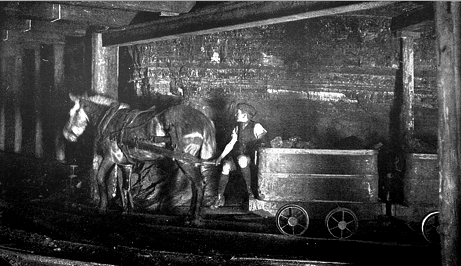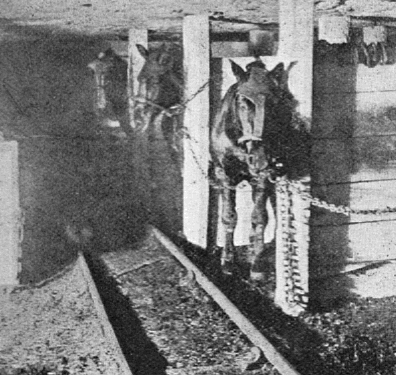PONTYPOOL GLYN PITS
Use of Horses

Horses were used in mines until the end of the twentieth century. In deep mines, they would spend most of their short lives without seeing the light of day. Many were killed due to explosion and accidents, as an example of this, the remains of nine horses are still buried at Glyn Pits after the disastrous underground fire of January 1890. The picture above illustrates the result of what appears to be an underground explosion, the horse has been killed and the trams piled in disarray. Although there were cases of abuse, in most cases, horses were very well cared for. In this context, it should be borne in mind that horses were worth more to the early mine owners than the men using them, and therefore would have been more expensive to replace. Even so, this must have been a miserable existence for them.
In 1931 there were 73,024 horses in British deep and shallow mines but were reduced to 32,109 by 1937 with the increase of machine power. Even though mechanical rope haulage engines were replacing horses, the coal still had to be removed from the coal face to the mechanical haulage, so for many years to come the horse played a large part in coal mining.

This photograph was taken in 1913.
Riding the Gun
Here we can see a lad of around 12 or 13 years old doing the job of underground haulage with a pony.
Around the body of the pony is a u-shaped iron bar called a shaft which is attached to something called a gun. The top of the gun is shaped like a swans neck and connects to the shaft, while the bottom of the gun is linked to the tram - hence linked together in this manner gained the term shaft and gun. You can see the lad holding the shaft with his right hand while at the same time sitting on the gun which was a very dangerous activity, to say the least, but was carried out by most people doing this job. The term was well known as riding the gun. " Just what today's Health and Safety people would have to say about the above practice, one can only imagine"

Most of these underground photographs were taken by Mr W. Jones of Hanbury Rd, Pontnewynydd, Pontypool in 1910.
Copyright belongs to the National Museum of Wales.
Note how the haulier has his lit candle in the front of his cap while at the same time smoking his clay pipe. You can see the shaft running from the horse's rump up to the level of its front legs. The leather traces were attached to this in order to take the weight and strain of pulling this tram, especially when it was full. Another thing of interest was the way a miner would have ties called 'Yorks' around the calves of his legs, to stop the bottom of his trousers from getting torn and wet. Judging from the body language of this horse it was a miserable job for any animal to do. Note also the horse's 'Nose bag' hanging around his neck. This was a 'Drift' mine, where the horse could be brought out to his stable every night. In deep mines, things were different, because there were not very many holidays then, which meant the horse would have seldom left the mine at all but would have stayed in the underground stables when at rest.

In this photograph, the horses can be seen at rest in their underground stables.